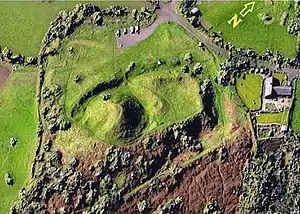List of motte-and-bailey castles
A motte-and-bailey is a form of castle, with a wooden or stone keep situated on a raised earthwork called a motte, accompanied by an enclosed courtyard, or bailey, surrounded by a protective ditch and palisade. Relatively easy to build with unskilled, often forced labour, but still militarily formidable, these castles were built across northern Europe from the 10th century onwards, spreading from Normandy and Anjou in France, into the Holy Roman Empire in the 11th century. The Normans introduced the design into England and Wales following their invasion in 1066. Motte-and-bailey castles were adopted in Scotland, Ireland, the Low Countries and Denmark in the 12th and 13th centuries. By the end of the 13th century, the design was largely superseded by alternative forms of fortification, but the earthworks remain a prominent feature in many countries.
Belgium
France
Ireland

- Ardee
- Ballymoty Motte
- Belturbet
- Castleruddery Motte
- Clough Castle
- Coleraine Castle
- Dún Dealgan Motte
- Fore Motte & Bailey
- Gortlownan Motte
- Granard Motte
- Greencastle
- Greenmount Motte
- Knockgraffon
- Lemonstown Motte
- Lickbla Motte & Bailey
- Moybologue (Relaghbeg) Motte & Bailey
- Navan Motte
- Portlick Motte
- Rathgarve Motte & Bailey
- Roscrea Castle
South Italy and Sicily
- Specchia Torricella near Supersano (Apulia)
- Vaccarizza near Troia (Apulia)
- Castle of Arechi (Salerno, Campania)
- San Marco Argentano (Calabria)
- Spezzano Albanese near Scribla (Calabria)
- Aci Castello (Sicily)
- Castle of Adrano (Sicily)
- Castle of Paternò (Sicily)
- Motta Sant'Anastasia (Sicily)
- Petralia Soprana (Sicily)
- Ponticelli of Segesta near Monte Barbaro (Sicily)
The Netherlands
United Kingdom
England
A study by castellologist D. J. Cathcart King in 1972 found 473 mottes in England.[2]
- Alnwick Castle
- Arundel Castle
- Baile Hill
- Bedford Castle
- Berkeley Castle
- Berkhamsted Castle
- Brinklow Castle
- Carisbrooke Castle
- Castle Acre Castle
- Castle Neroche
- Caus Castle
- Chartley Castle
- Christchurch Castle
- Clare Castle
- Clifford Castle
- Clitheroe Castle
- Corfe Castle
- Cuckney Castle
- Cymbeline's Castle
- Dorstone Castle
- Dudley Castle
- Durham Castle
- Eardisland Castle
- Eardisley Castle
- Edburton Castle Ring
- Ewyas Harold Castle
- Eye Castle
- Farnham Castle
- Fenny Castle
- FitzHarris Castle
- Fotheringhay Castle
- Hastings Castle
- Holwell Castle, Parracombe
- Kilpeck Castle
- Launceston Castle
- Lewes Castle
- Leafield Castle
- Lincoln Castle
- Longtown Castle
- Montacute Castle
- Nether Stowey
- Norwich Castle
- Nottingham Castle
- Okehampton Castle
- Old Sarum Castle
- Ongar Castle
- Oxford Castle
- Pickering Castle
- Pleshey Castle
- Reigate Castle
- Sandal Castle
- Skipsea Castle
- Stafford Castle
- Stansted Mountfitchet Castle
- Tamworth Castle
- Thetford Castle
- Tonbridge Castle
- Totnes Castle
- Totternhoe Castle
- Tutbury Castle
- Wallingford Castle
- Warkworth Castle
- Warwick Castle
- Windsor Castle
- York Castle
Scotland


Canmore has records for 46 motte-and-bailey castles in Scotland.[3]
- Doune of Invernochty, Aberdeenshire
- Duffus Castle, Moray
- Hermitage Castle, Liddesdale
- Liddel Castle, Liddesdale
- Motte of Urr, Dumfries and Galloway
- Tibbers Castle, Dumfries and Galloway
Northern Ireland
- Dromore Castle
Wales
A 1972 study found 268 mottes in Wales.[2]
- Aberlleiniog Castle
- Buddugre Castle
- Cardiff Castle
- Lampeter Castle
- Llandovery Castle
- Mold Castle
- Montgomery or Hen Domen
- New Radnor
- Prestatyn Castle
- St Quentins Castle
- The Rofft
- Tomen Castell
- Wiston Castle
- Wolfscastle
- Twyn Castell (Gelligaer)
References
Notes
- Historic England. "Castle Pulverbatch motte and bailey castle with outer bailey, 100m NNW of Brook Cottage (1012860)". National Heritage List for England. Retrieved 28 July 2017.
- King 1972, pp. 102, 104
- "Sites (46) | Canmore". Retrieved 2017-03-23.
Bibliography
- King, D. J. Cathcart, "The field archaeology of mottes in England and Wales: eine kurze übersichte", Château Gaillard: Études de castellologie médiévale, 5: 101–117
External links
| Wikimedia Commons has media related to Motte and bailey. |
| Wikisource has the text of the 1911 Encyclopædia Britannica article Bailey. |
